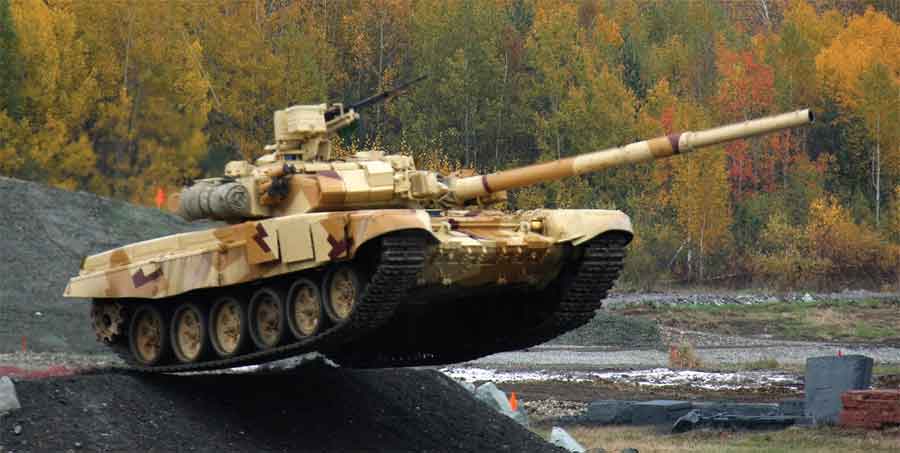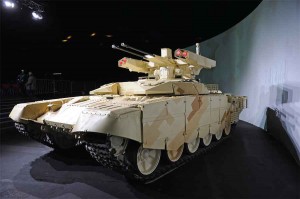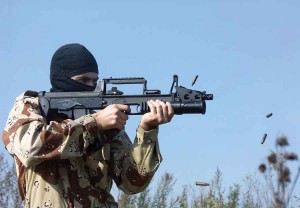Today, some 70% of India’s weapons and arsenals are manufactured in Russia. However, in recent years Russia’s military complex faces the stiffening competition on the part of foreign rivals, the US and Israel in the first place.
India is our strategic partner with whom we have cooperated for over 50 years. Ours are very deep and confidential relations, materialized, among other things, in the transfer of high technologies.
According to Alexander Fomin, director of the Federal Service for Military-Technical Cooperation (FSMTC), in 2013 India still remained Russia’s largest partner in military collaboration with foreign countries. “India is the principal consumer of our defense materiel both in general terms and in individual types of weapons. Last year, India was still our number one customer for defense products. By rough estimate, this makes up 30% of all of our military exports in terms of cost,” said A.Fomin.
Assuring, in 2013, US$ 13 billion worth of arms sales, Rosoboronexport brought up the total of defense order portfolio to US$ 38.5 billion. Under the current contracts, each year it ships defense products to India worth around US$ 3 billion.
“India is our strategic partner with whom we have cooperated for over 50 years. Ours are very deep and confidential relations, materialized, among other things, in the transfer of high technologies. We have been doing this for several decades now. With our assistance India has built many defense enterprises. Some technologies have been made available to our Indian partners literally 100% complete,” said the head of FSMTC. In his words, “it’s hard to find another instance of such partnership.”
During Russian President Vladimir Putin’s visit to India in October 2013 and his talks with India’s Prime Minister Manmohan Singh, Russia and India agreed to expand cooperation in rocket engineering, naval technologies and weapon systems. Specifically, the parties pointed out the achievements in joint design, development and production of high-tech weapons and implementation of such projects as creation of the fifth-generation fighter aircraft (FGFA), multi-role transport aircraft (MTA) and BrahMos supersonic missile. Participants of the talks also welcomed the transfer to India in 2013 of the Russian-built Trigand frigate, the course of licensed production in India of the Su-30MKI aircraft and T-90S tanks, and the successful completion of trials of the aircraft carrier Vikramaditya.
Putin and Singh pointed out that “the two countries’ traditionally close cooperation in defense matters is a key factor in the Russo-Indian partnership, showing the high level of trust between the two states.”
On the eve of his visit to Russia, in an interview to the Russian journalists Mr. Singh revealed that India plans to finish as soon as possible the comprehensive engineering work on the joint projects to create the FGFA and MTA and start their series production. According to him, India regards those projects as milestones in the Indo-Russian military and technical cooperation. “They symbolize the transformation of our defense relations from the former “buyer-and-seller” status to the one that includes joint design, development and production of defense products,” said the Prime Minister.
Some of the Russian exhibits are expressly designed for the Indian market and will be demonstrated in New Delhi for the first time.
That is why the Russian defense enterprises actively participate in the DEFEXPO-2014 exhibition of land, naval and internal security systems. Some of the Russian exhibits are expressly designed for the Indian market and will be demonstrated in New Delhi for the first time.
In particular, the most interesting Russian exhibits will include an upgrade package for the T-72 main battle tank (MBT). This will be presented by the Uralvagonzavod Corporation (UVZ). The T-72 tank is currently the most widely used tank in service with 40 odd countries across the globe. The T-72 tank modernization projects are a particularly pressing issue in the light of latest military conflicts taking place mainly in urban conditions.
The UVZ offers two T-72 tank modernization projects which, following the implementation, make the machine into one of world’s best modern tanks. The first project envisions fitting the T-72 with a set of protection gear to ensure the crew’s survival in an urban warfare where anti-tank weapon systems, including radio-controlled mine obstacles, are employed.
The upgraded T-72 MBT may be fitted with dedicated devices, including roadblocks and debris removing systems, for operation in a city. This enables the tank commander to fire from a protected machinegun mount. The auxiliary gear includes a modular set of ERA on the tank sides and turret, protection of the cabin type of the anti-aircraft machinegun mount (commander’s cabin), RP-377UVM1L remotely controlled explosives neutralization system, and TBS-86 bulldozer.
The tank provides high firepower, superior agility and excellent protection. Installed on the tank are the 2A46M5 cannon and automatic loader that enable firing missiles to a range of up to 5 km. The gun-layer sight with an optical thermal imaging channel ensures a day-and-night operation of the machine in all weathers. The rangefinder measures the distance out to 7 km.
The second project is the upgraded T-72 tank fitted with the Arena-E hard-kill active protection system (APS) giving the tank a 360 degree protection against anti-tank weapon systems, anti-tank grenade launchers, artillery shaped charge projectiles and anti-tank guided missiles, including those attacking the tank in an over-flight.
Over recent years Russia and India ought to have realized that they must set up more joint ventures to develop and subsequently produce defense products.
The DEFEXPO-2014 exhibition presents a new configuration of hard-kill APS enabling placement of the Arena-E on virtually all types of vehicles. This differs from the previous version of APS in that the onboard radar station is divided into several units placed so that it does not hamper the tank in performance of other duties. The new version of the Arena-E can be fitted on the T-72, T-72B, T-90 and other types of tanks.
The UVZ makes the first presentation in India of its Terminator-2 BMPT-72 tank support vehicle. This is one of the T-72 upgrade versions. The machine is built using the undercarriages of the T-72 tanks now being withdrawn from service. The BMPT-72 machine can be built at the customers’ repair facilities with the use of upgrade packages supplied by the UVZ.
The development of the BMPT-72 took into account the experience of creating and using the basic Terminator BMPT version. The Terminator-2, like its basic prototype, provides a high level of firepower, protection, and controllability by the commander. It can effectively perform the functions of fire support for tanks and infantry in all types of hostilities, in various climates and at all times of day and night. However, the BMPT-72 differs from the previous model in a number of aspects such as an improved fire control and orientation system; the first, on such tanks, protection of guided missile launchers against fragments and small arms; a provision for installation of a more powerful propulsion unit; as per customer request, the machine can be fitted with a 840 to 1,000 hp powerplant and communications systems of Russian or other country’s manufacture; the tank crew can be reduced to 3 men.
The chief advantage of the BMPT-72 is that as a T-72 platform-based system it extends the machine’s service life and raises the land force’s operational capability at a minimum cost.
The BMPT-72 combat weight is 44 tons. Mounted on the machine is a powerful automatic weapon system including two 2A42 30mm automatic cannons and the PKTM 7.62mm machine gun, twinned with them and enabling neutralization of lightly armored targets and manpower. Two twin launchers contain supersonic missiles capable of destroying highly protected targets in the entire firing range with a kill probability close to 100%.
The automatic weapons are amply supplied with ammunition, up to 850 rounds for the cannons and 21,000 for the twin machinegun. All the remotely controlled weapons (automatic cannons, machinegun, and guided missiles) are placed on the superstructure outside the manned compartment. The automatic fire control system operates round the clock using a multi-channel sighting device ensuring a reliable detection, identification and destruction of targets.
The UVZ makes the first presentation in India of its Terminator-2 BMPT-72 tank support vehicle. This is one of the T-72 upgrade versions.
The Tula-based KBP Instrument Design Bureau from JSC NPO “High-Precision Weapons” presents for the first time in India its ADS automatic rifle capable of operating in two media. At present it has no analogues on the small arms market. The automatic rifle is designed on the bullpup principle. The key feature of this specimen of weapon is the ammunition it uses. The specialists of the Central Design and Research Bureau of Sporting and Hunting Weapons, a branch of the KBP, created a special underwater cartridge based on the standard 5.45×39 case denoted as PSP-UD. This is contained in the Kalashnikov rifle’s (as designed in 1974) standard 30-round magazine. The rifle can simultaneously fire all types of 5.45 mm munitions. Thus the KBP specialists resolved the problem of using the rifle in two media. For switching between the above- and underwater fire the weapon barrel has a special fire mode selector. The used cartridges are ejected forward through a short pipe on the right side of the barrel. Such a design decision is resorted to for the first time. This has reduced the gas accumulation in front of the rifleman’s face.
The automatic rifle is fitted with the Picatinny rail for mounting various sights. Instead of the under-barrel grenade launcher it is possible to fit the Skat hydro-acoustic search and track system. The rifle has a set of on-barrel devices, including a general purpose noise reducer, blank cartridge firing device, and compensating flash-hider. In the future, it may be fitted with a laser target designator and tactical target searcher. Also, the ADS rifle has a 40 mm under-barrel grenade launcher capable of firing VOG-25 and VOG-25P grenades.
The trigger has an automatic safety catch reliably protecting from a shot during the weapon fall. The under-barrel grenade launcher is fitted with a pendulum safety. The developers claim such safeties do not hamper effective firing with a diver’s gloves on. Thanks to a special weight distribution, whose centre is in the ADS handgrip area, the weapon can be fired one-handed.
The underwater cartridge firing range is 40 m at a depth of 5 m, in above water conditions it is 500-600 m. PSD-UD rounds can be fired on land.
Russia has made a great deal of progress in cooperation with India on developing and producing the BRAHMOS family of supersonic cruise missiles. Dr. A.Sivathanu Pillai, head of BrahMos Aerospace Company, believes Russia will outstrip its competitors in India by establishing joint enterprises here. “From the 1960s through the 1980 India fully depended on contracts with the USSR and on the transfer of Soviet technologies,” he said. “After the breakup of the Soviet Union, new rivals emerged here for Russia. Supplying their weapons and equipment, they will reduce the scope of the Russo-Indian defense cooperation.”
According to him, “Over recent years Russia and India ought to have realized that they must set up more joint ventures to develop and subsequently produce defense products. The development of BRAHMOS cruise missiles successfully shows it could be done,” explained Pillai. “India and Russia are great friends. I’d rather say that Russia is a sole true friend of India. If we wish to maintain the former scale of defense cooperation, we must increase the number of joint ventures, especially those engaged in the development of high-technology products. This will enable Russia to outperform and leave behind its rivals in India.”









“During Russian President Vladimir Putin’s visit to India in October 2013 and his talks with India’s Prime Minister Manmohan Singh, Russia and India agreed to expand cooperation in rocket engineering, naval technologies and weapon systems.”
You stated this in your article which is wrong. Mr. Manmohan singh visited to Russia. I think Mr. Putin never visited India after December -2012